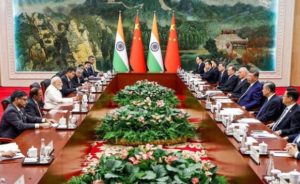TIANJIN ŌĆö In a milestone moment for AsiaŌĆÖs geopolitical landscape, Chinese President Xi Jinping and Indian Prime Minister Narendra Modi met on the sidelines of the Shanghai Cooperation Organisation (SCO) summit in Tianjin. Their high-profile engagement marks ModiŌĆÖs first visit to China in seven years and has produced an optimistic rebranding of bilateral relations.
During their discussions, Modi emphasized a newfound ŌĆ£atmosphere of peace and stabilityŌĆØ along the Himalayan border, asserting that this thaw benefits the 2.8 billion people across the two nations. He pledged to advance ties based on mutual trust, respect, and sensitivity.
Xi framed the relationship in strategic and harmonious terms, characterizing China and India as ŌĆ£development opportunities rather than threatsŌĆØ and urging a view of each other as partners, not rivals. He invoked the idiom of a ŌĆ£dance of the dragon and the elephantŌĆØ to illustrate a collaborative path forward.
Dialogue Deepens Amid Global Tensions
As part of broader diplomatic gestures, India and China announced plans to resume direct flights after more than five yearsŌĆöa move signaling normalizing relations. Airlines are already preparing routes, though no exact timeline has been specified.
Their talks also navigated longstanding border issues, with leaders reaffirming cooperation to maintain peace and strengthen communication mechanisms in the Ladakh region following a 2020 stand-off.
The economic backdrop to this softening is equally compelling: the United States recently imposed steep 50% tariffs on Indian goods due to its ongoing Russian oil purchasesŌĆöan external pressure that has driven India closer to China and Russia.
Regional Strategy Under the SCO Umbrella
IndiaŌĆÖs presence alongside Xi and Russian President Vladimir Putin at the SCO summit underscores a multipolar tilt in Asia, leveraging the regional blocŌĆÖs collective positioning against Western dominance.
Both leaders articulated a shared interest in deepening trade and investment ties amid global tariff volatility. Modi requested greater access for Indian goods in China and addressed the trade deficit, while Xi called for handling bilateral ties from a strategic, long-term perspective.
Strategic Realignment: Navigating Between the U.S. and China
ModiŌĆÖs diplomatic balancing act reflects IndiaŌĆÖs recalibrating foreign policy in response to U.S. unpredictability and tariff aggression. His earlier Japan visit to strengthen ties with Tokyo, followed by his arrival in Tianjin, signals India’s pivot towards Asian solidarityŌĆönotably with China and Japan.
Despite the positive developments, structural challenges remain. India faces a large trade deficit with China, internal trust deficits persist, and geopolitical tensions continue over Tibet and China’s regional influence.
Global Outlook is Shifting
In summation, the SCO meeting in Tianjin heralds a strategic thaw in IndiaŌĆōChina relations. As Modi and Xi advance communications, restore air links, and thaw long-frozen sanctions, the global outlook is shifting. This reset, influenced by U.S. trade pressure, underscores a new era where AsiaŌĆÖs giants embrace cooperation amid a contested global order. (zai)

